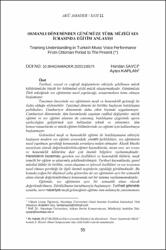| dc.contributor.author | Savcı, Handan | |
| dc.contributor.author | Kaplan, Ayten | |
| dc.date.accessioned | 2021-07-27T13:19:45Z | |
| dc.date.available | 2021-07-27T13:19:45Z | |
| dc.date.issued | 27.01.2020 | en_US |
| dc.identifier.citation | Savci, H , Kaplan, A . (2020). OSMANLI DÖNEMİNDEN GÜNÜMÜZE TÜRK MÜZİĞİ SES İCRASINDA EĞİTİM ANLAYIŞI . Afyon Kocatepe Üniversitesi Akademik Müzik Araştırmaları Dergisi , 6 (11) , 55-72 . Retrieved from https://dergipark.org.tr/tr/pub/amader/issue/52410/618307 | en_US |
| dc.identifier.uri | https://dergipark.org.tr/tr/pub/amader/issue/52410/618307 | |
| dc.identifier.uri | https://hdl.handle.net/11630/8937 | |
| dc.description.abstract | Tarihsel, sosyal ve coğrafi değişimlerin etkisiyle şekillenen müzik kültürümüzün büyük bir bölümünü sözlü müzik oluşturmaktadır. Günümüzde Türk müziğinde ses eğitiminin nasıl yapılacağı, araştırmalara konu olmaya başlamıştır.
Tanzimat öncesinde ses eğitiminin meşk ve hanendelik geleneği ile özdeş olduğu söylenebilir. Tanzimat dönemi ile birlikte başlayan batılılaşma politikaları, Cumhuriyet döneminde daha etkin biçimde uygulanmıştır. Cumhuriyet döneminde, tüm kurumlarda yaşanan radikal değişimler, müzik eğitimi ve ses eğitimi alanına da yansımış, batılılaşma çizgisinde opera şarkıcılığını geliştirmek için kullanılan teknik ve yöntemler, tüm konservatuarlarda ve müzik eğitimi bölümlerinde ses eğitimi için kullanılmaya başlanmıştır.
Geleneksel meşk ve hanendelik eğitimi ile batılılaşmanın etkisiyle başlayan modern ses eğitimi arasındaki yöntem farklılıkları, ses eğitiminin nasıl yapılması gerektiği konusunda sorunlara neden olmuştur. Klasik Musiki nazariyatı olarak değerlendirebileceğimiz kaynaklarda, insan sesi, ses icrası ve hanendelik kültürüne dair çok önemli bilgilere rastlanmaktadır. Hanendenin kazanması gereken ses özellikleri ve hanendelik kültürü, meşk temelli bir eğitim ve aktarımla şekillendirilmiştir. Tarihsel kaynaklarda, genel müzikal kültür ile birlikte, sesin oluşumu ve işlevsel özellikleri ve ses icrasının nasıl olması gerektiği ile ilgili önemli tespitlerin yapıldığı görülmektedir. Bu konuda yoğun bir düşünsel çaba gösterilse de ses eğitiminin ayrı bir uzmanlık alanı olarak değerlendirilmesi konusunda net bir tutuma rastlanmamaktadır.
Eğitimde, ses eğitiminin ayrı bir uzmanlık alanı olarak değerlendirilmesi, Dârülelhanın kurulmasıyla başlamıştır. Tarihsel gelenekle uyumlu, tavır-nazariyat-meşk geleneğinin eğitime tam anlamıyla yansımaması bugünün ses icrasının en önemli sorunlarından biridir. Bu çalışmada, ses icrası ve ses eğitiminin gelenekte nasıl şekillendiği, tarihsel müzik kültürümüzü şekillendiren kaynaklar, meşk ve Osmanlı eğitim kurumları temel alınarak belirlenmeye çalışılmıştır. | en_US |
| dc.description.abstract | The majority of our music culture, shaped by the influence of historical, social and geographical changes, is formed by verbal music. In the recent years, the voice training techniques in Turkish music have been the subject for many studies.
It can be said that before the “Tanzimat Period” the education for voice performance were following the traditional master-apprentice relationship. Of course this method for education has changed quite a lot after the “Tanzimat Period”, especially during the Republican Period due to the “Westernization Policies” that had affected the culture of these era.
During the Republic period, radical changes in all institutions were also reflected in the field of music education and voice performance training, technics and methods that have originally been used to improve opera style singing have been used for voice training in all conservatories and music education departments regarding all kinds of music styles and genres.
The differences between the methods of traditional „master-apprentice based training (meşk)‟ and „traditional singing (hanendelik)‟ performance education and the modern voice training techniques which had been started with the effect of westernization, led to an inconsistency in the methods and techniques that should be used for voice performance education. In fact, the sources that can be classified within the “Turkish classical music literature” very important information about the human voice, voice performance and traditional singing styles may be observed, that were not transferred to the current education.
The voice characteristics that the singer should gain to achieve a good performance level had been shaped by practice oriented education. In historical sources, along with general musical culture, significant determinations have been made on the formation of “singing”, its functional properties and the necessary characteristics that should be obtained in a successful voice performance. Although an intense intellectual emphasis has been dedicated on this issue, there is no clear attitude to define voice training as an independent area of expertise.
The evaluation of voice training as an independent area of expertise had been started with the establishment of Darülelhan-the first western style conservatory of Ottoman Era. The lack of the reflection of traditional voice training styles supported by the traditional theory education to the current “voice performance education” seems to be the major problem of today‟s voice performance world in Turkey. In this study, it is tried to be determined how voice performance and voice training should be shaped in today‟s music world to be based on the historical back ground formed by the traditional music culture, traditional practice and Ottoman educational institutions. | en_US |
| dc.language.iso | tur | en_US |
| dc.publisher | Afyon Kocatepe Üniversitesi | en_US |
| dc.identifier.doi | https://doi.org/10.36442/AMADER.20201158175 | en_US |
| dc.rights | info:eu-repo/semantics/openAccess | en_US |
| dc.subject | Ses Eğitimi | en_US |
| dc.subject | Hanendelik | en_US |
| dc.subject | Meşk | en_US |
| dc.subject | Osmanlı Eğitim Kurumları | en_US |
| dc.subject | Voice Training | en_US |
| dc.subject | Master | en_US |
| dc.subject | Apprentice Based Training | en_US |
| dc.subject | Traditional Singing | en_US |
| dc.subject | Ottoman Educational Institutions | en_US |
| dc.subject | Ses | en_US |
| dc.subject | Voice | en_US |
| dc.title | Osmanlı döneminden günümüze Türk Müziği ses icrasında eğitim anlayışı | en_US |
| dc.title.alternative | Training understanding in Turkish Music voice performance from ottoman period to the present | en_US |
| dc.type | article | en_US |
| dc.relation.journal | Akademik Müzik Araştırmaları Dergisi “AMADER” | en_US |
| dc.department | Seçiniz | en_US |
| dc.authorid | 0000-0002-4579-3425 | en_US |
| dc.identifier.volume | 6 | en_US |
| dc.identifier.startpage | 55 | en_US |
| dc.identifier.endpage | 72 | en_US |
| dc.identifier.issue | 11 | en_US |
| dc.relation.publicationcategory | Makale - Ulusal Hakemli Dergi - Başka Kurum Yazarı | en_US |



















